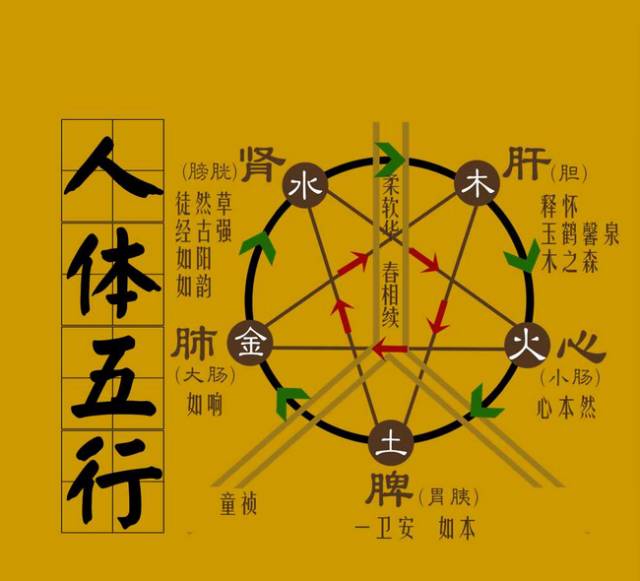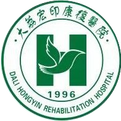
Daoist medicine views the human body and the universe as a unified system governed by the principles of circular motion of material forces. The principles of material forces are similar in both Western and Chinese medicine, but the methods of their movement differ. The movement of material forces in Daoist medicine is holistic, circular, and dynamic. When Western medical terminology is introduced, the true essence of Daoist medicine can become obscured.
1. The Generating and Overcoming Relationships of the Five Elements
Each of the Five Elements possesses unique capabilities. Wood has the ability to disperse, Fire has the ability to promote, Metal has the ability to contract, Water has the ability to store, and Earth has the ability to transform. These capabilities are also referred to as forces or actions.
Spring energy arises from winter energy, hence it is said that Water generates Wood. Summer energy arises from spring energy, hence it is said that Wood generates Fire. The energy of late summer arises from summer energy, hence it is said that Fire generates Earth. Autumn energy arises from late summer energy, hence it is said that Earth generates Metal. Winter energy arises from autumn energy, hence it is said that Metal generates Water. The period between summer and autumn is referred to as late summer.
The contracting action restrains the dispersing action, hence it is said that Metal overcomes Wood. The promoting action restrains the contracting action, hence it is said that Fire overcomes Metal. The storing action restrains the promoting action, hence it is said that Water overcomes Fire. The transforming action restrains the storing action, hence it is said that Earth overcomes Water. The dispersing action restrains the transforming action, hence it is said that Wood overcomes Earth. Transformation refers to the process of movement and combination. Promotion refers to the dispersal of heat and circulation. Earth overcoming Water indicates that Earth can damage moisture.
The generating relationship represents the sequential order of the circular movement of the atmosphere. The overcoming relationship represents the balance of opposing forces in the circular movement. Generating relationships supplement deficiencies, while overcoming relationships restrain excesses. The interplay of generating and overcoming is merely the self-sustaining circular motion of the movement itself. The harmony of human and cosmic energies leads to health. When movement is circular, there is peace; likewise, when there is peace, movement is circular. Generating leads to growth, while overcoming leads to balance. The interplay of generating and overcoming is fundamental to the physiology, pathology, and medical principles of Daoist medicine. The circular movement of the Five Elements throughout the year can be summarized in a single day. The circular movement of the Five Elements in a day can be summarized in a single breath. Each inhalation and exhalation represents the rise and fall of atmospheric energy within the human body, forming a complete whole. The term ‘heaven’ in relation to humanity signifies the entirety of creation.
The Five Organs: Lungs, Liver, Kidneys, Heart, Spleen
The Six Bowels: Large Intestine, Gallbladder, Bladder, Small Intestine, Stomach
The Five Elements: Metal, Wood, Water, Fire, Earth
The Five Tastes: Spicy, Sour, Salty, Bitter, Sweet
Traditional Chinese Medicine (TCM) describes certain physiological characteristics and functions of the Five Organs based on the properties of the Five Elements. For example, Wood is flexible and can bend or straighten, flowing smoothly; the Liver belongs to Wood and is characterized by its preference for smooth flow and aversion to stagnation, possessing the function of dispersal; Fire is warm and ascendant, the Heart belongs to Fire and is characterized by its warming function; Earth is nurturing and has the ability to generate all things, the Spleen belongs to Earth and is responsible for digesting food and transporting nutrients to nourish the Five Organs and Six Bowels, serving as the source of Qi and Blood; Metal is clear and astringent, the Lungs belong to Metal and are characterized by their function of clearing and descending; Water is moistening and has the ability to descend and store, the Kidneys belong to Water and are responsible for the metabolism of body fluids and the storage of essence.
The theory of the Five Elements posits that there are relationships of generation, overcoming, and mutual restraint among them. The generating sequence is: Wood generates Fire, Fire generates Earth, Earth generates Metal, Metal generates Water, Water generates Wood. The overcoming sequence is: Wood overcomes Earth, Earth overcomes Water, Water overcomes Fire, Fire overcomes Metal, Metal overcomes Wood. If the generating or overcoming relationships are excessive or insufficient, the normal balance will be disrupted, leading to mutual restraint or aggression. Mutual restraint occurs when one element excessively restrains another. For example, if Wood is overly vigorous and Metal cannot adequately restrain it, Wood will excessively overcome Earth, leading to its deficiency, which is termed Wood overcoming Earth. Mutual aggression occurs when one element is too strong, preventing the element that should restrain it from doing so, resulting in the former dominating the latter, also known as reverse overcoming or aggression. For instance, under normal circumstances, Water overcomes Fire, but if Water is too scarce or Fire is too strong, Water cannot overcome Fire and may instead be dried up by it, which is termed Fire reverse overcoming or aggression against Water. The interplay of generating and overcoming is inseparable; without generation, things cannot arise and grow; without overcoming, things cannot maintain normal relationships. Only by maintaining a dynamic balance of generating and overcoming can normal occurrences and developments take place.
The relationships of generating and overcoming are widely applied in TCM to explain the relationships between the Five Organs, the pathological influences among the organs, and the corresponding diagnoses and treatments.
The mutual generating relationships among the Five Organs can be elucidated through the generating relationships of the Five Elements. For example, the Kidneys (Water) store essence, the Liver (Wood) stores blood, and Kidney essence can transform into Liver blood, which means that Kidney Water nourishes Liver Wood, hence Water generates Wood; the Liver (Wood) stores blood, the Heart (Fire) governs the blood vessels, and the normal function of the Liver in storing blood and regulating blood volume supports the Heart’s function in governing blood vessels, which means that Liver Wood supports Heart Fire, hence Wood generates Fire; the Heart (Fire) governs blood vessels and spirit, while the Spleen (Earth) governs transformation and is the source of Qi and Blood, also governing blood regulation. The warmth of Heart Yang can warm and promote Spleen Yang, allowing the Heart’s function in governing blood vessels to nourish the Spleen, which means that Heart Fire warms Spleen Earth, hence Fire generates Earth; the Spleen (Earth) can transport nutrients and benefit the Lungs (Metal), thus maintaining the Lung’s function in governing Qi, which means that Spleen Qi nourishes Lung Qi, hence Earth generates Metal; the Lungs (Metal) govern Qi and are responsible for clearing and descending, while the Kidneys (Water) govern the storage of essence and intake of Qi. The descending of Lung Qi aids in the closure and intake of Kidney essence, allowing Lung Qi to descend and regulate Water pathways, thus promoting the Kidney’s function in governing Water, which means that Lung Metal nourishes Kidney Water, hence Metal generates Water.
Similarly, the overcoming relationships among the Five Elements are also used to explain the mutual restraint among the Five Organs. For instance, the descending and clearing action of Lung (Metal) Qi can suppress the excessive Yang of the Liver (Wood), which means that Metal overcomes Wood; the smooth flow of the Liver (Wood) can relieve the stagnation of the Spleen (Earth), which means that Wood overcomes Earth; the transformation of the Spleen (Earth) can restrain the flooding of the Kidneys (Water), which means that Earth overcomes Water; the nourishing action of the Kidneys (Water) can prevent the excessive heat of the Heart (Fire), which means that Water overcomes Fire; the Yang heat of the Heart (Fire) can restrain the excessive clearing of the Lungs (Metal), which means that Fire overcomes Metal.
The generating and overcoming relationships are also used to explain the pathological influences among the organs. For example, Liver disease can affect the Spleen, which is Wood overcoming Earth; Spleen disease can also affect the Liver, which is Earth aggression against Wood; mutual influence occurs when both the Liver and Spleen are affected, which can be described as Wood stagnation and Earth deficiency or Earth obstruction and Wood stagnation; Liver disease can also affect the Heart, which is a maternal disease affecting the child; it can influence the Lungs, which is Wood aggression against Metal; and it can affect the Kidneys, which is a child disease affecting the mother. Other organ pathologies can also be explained using the relationships of generating, overcoming, and mutual aggression.
TCM theory posits that the Five Tastes correspond to the Five Organs and Six Bowels: “Sour enters the Liver, Spicy enters the Lungs, Bitter enters the Heart, Salty enters the Kidneys, Sweet enters the Spleen.” “Each taste has its own path and corresponding diseases. Liver disease should avoid Spicy, Heart disease should avoid Salty, Spleen disease should avoid Sour, Kidney disease should avoid Sweet, and Lung disease should avoid Bitter.” The Lungs govern Qi, the Heart governs blood vessels, the Liver governs tendons, the Spleen governs flesh, and the Kidneys govern bones. Dietary practices should emphasize these principles of suitability and avoidance, making reasonable use of the Five Tastes to promote health and prevent diseases caused by excessive preferences.
 Long press the image below, click to recognize the QR code to follow the WeChat public account of Dali Hongyin Hospital. Timely receive news updates and relevant medical knowledge from Hongyin Hospital, and understand the various medical policies of Hongyin Hospital.
Long press the image below, click to recognize the QR code to follow the WeChat public account of Dali Hongyin Hospital. Timely receive news updates and relevant medical knowledge from Hongyin Hospital, and understand the various medical policies of Hongyin Hospital.


